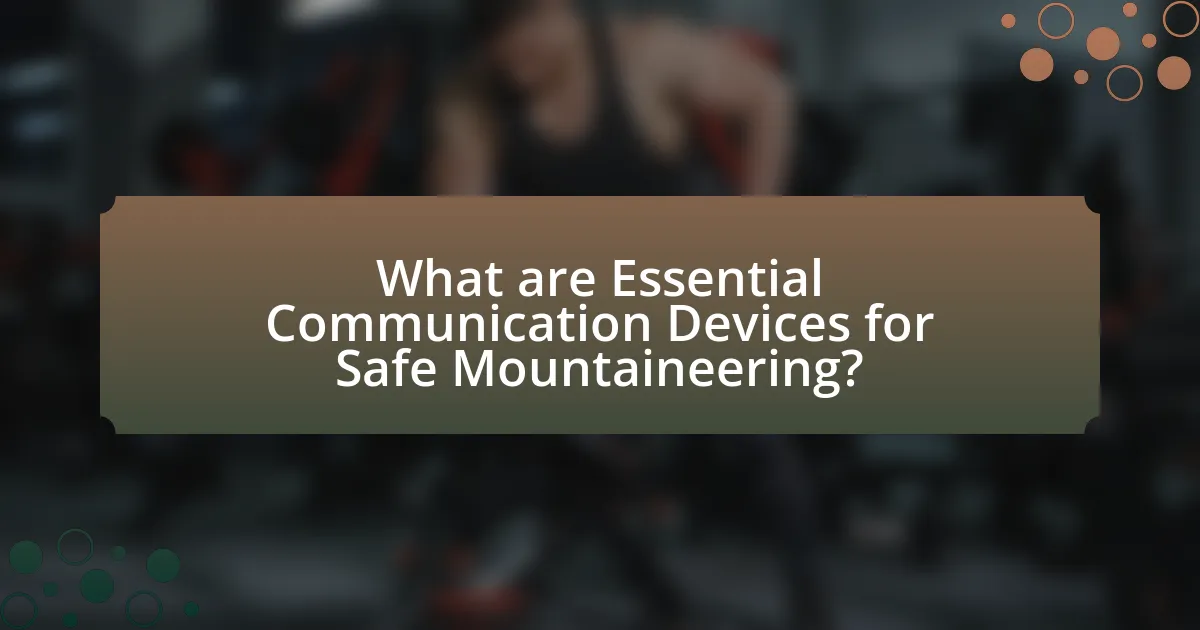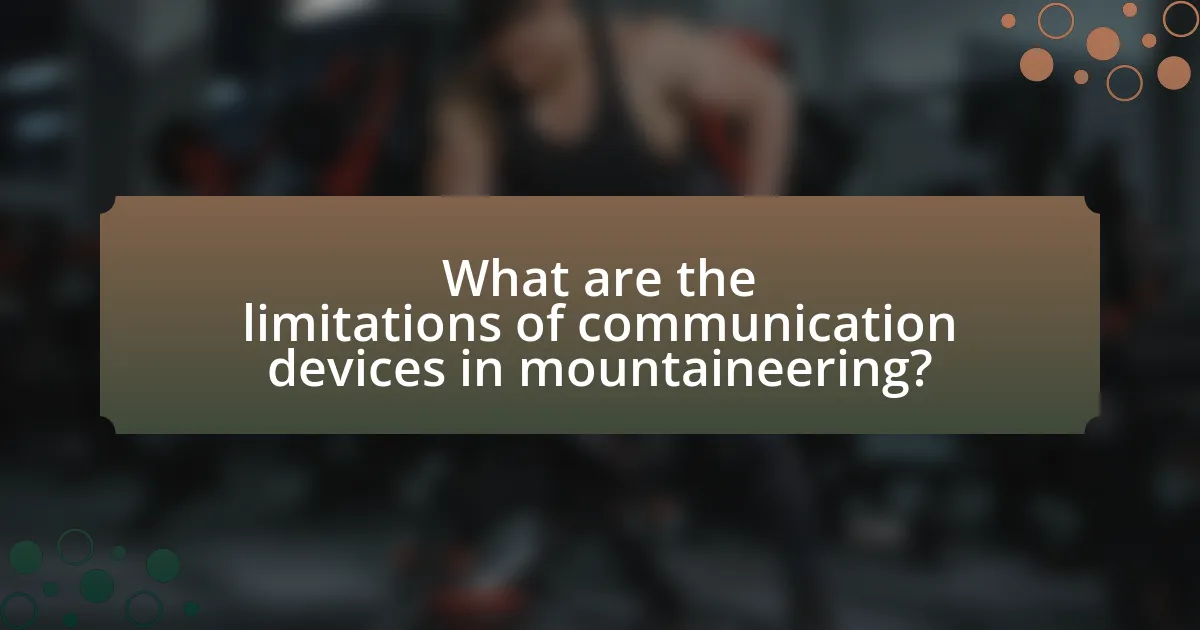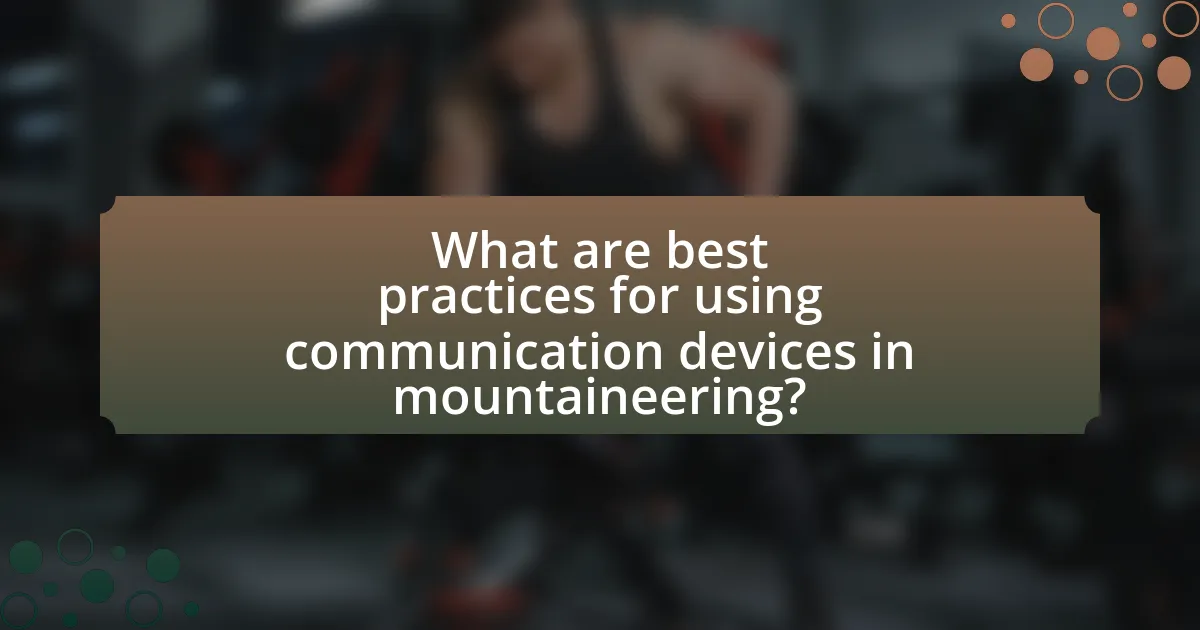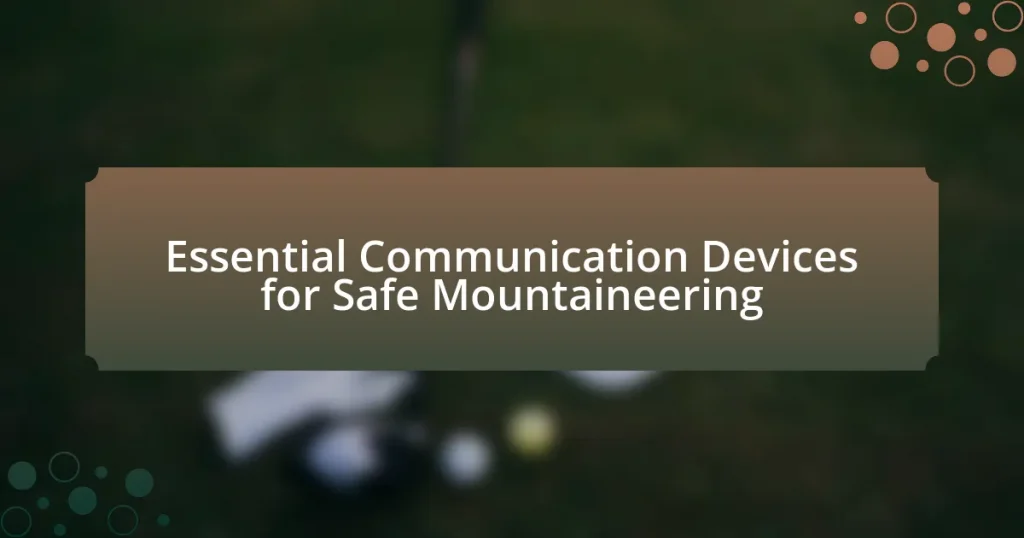Essential communication devices for safe mountaineering include satellite phones, two-way radios, and personal locator beacons (PLBs), each playing a crucial role in enhancing climber safety and coordination. These devices facilitate real-time communication, enabling climbers to report emergencies and receive timely assistance, thereby significantly improving survival rates. The article explores how these devices mitigate risks associated with navigation, injury, and delayed rescue, while also discussing their limitations, maintenance tips, and best practices for effective use in challenging mountain environments. Additionally, it highlights the importance of training and preparedness in ensuring reliable communication during expeditions.

What are Essential Communication Devices for Safe Mountaineering?
Essential communication devices for safe mountaineering include satellite phones, two-way radios, and personal locator beacons (PLBs). Satellite phones provide reliable communication in remote areas where cellular signals are unavailable, allowing climbers to contact emergency services or coordinate with team members. Two-way radios facilitate instant communication among team members, enhancing coordination and safety during climbs. Personal locator beacons are crucial for emergency situations, as they send distress signals with GPS coordinates to rescue services, significantly increasing the chances of a timely rescue. These devices are vital for ensuring safety and effective communication in challenging mountain environments.
How do these devices enhance safety during mountaineering?
Essential communication devices enhance safety during mountaineering by enabling real-time communication between climbers and their support teams. These devices, such as satellite phones and two-way radios, allow for immediate reporting of emergencies, facilitating quicker rescue operations. For instance, studies show that climbers equipped with reliable communication tools can reduce response times in emergencies by up to 50%, significantly increasing survival rates. Additionally, GPS-enabled devices provide accurate location tracking, which is crucial for navigation and coordinating rescue efforts in challenging terrains.
What specific risks do communication devices mitigate in mountaineering?
Communication devices mitigate several specific risks in mountaineering, including the risk of getting lost, the risk of injury or medical emergencies, and the risk of delayed rescue. These devices, such as satellite phones and two-way radios, enable climbers to maintain contact with their team and emergency services, ensuring that they can receive assistance promptly if needed. For instance, studies show that timely communication can significantly reduce the time taken for rescue operations, thereby increasing the chances of survival in critical situations. Additionally, GPS-enabled devices help climbers navigate challenging terrains, minimizing the likelihood of disorientation and accidents.
How do communication devices facilitate rescue operations?
Communication devices facilitate rescue operations by enabling real-time coordination and information sharing among rescue teams and individuals in distress. These devices, such as satellite phones, two-way radios, and GPS trackers, allow rescuers to quickly assess situations, pinpoint locations, and communicate vital instructions. For instance, the use of GPS technology can improve the accuracy of locating stranded individuals, significantly reducing response times. According to a study published in the Journal of Mountain Medicine, effective communication during rescue missions can enhance success rates by up to 30%, demonstrating the critical role these devices play in saving lives during emergencies.
What types of communication devices are commonly used in mountaineering?
Commonly used communication devices in mountaineering include two-way radios, satellite phones, and personal locator beacons (PLBs). Two-way radios facilitate direct communication between climbers, allowing for real-time updates and coordination. Satellite phones provide reliable communication in remote areas where cellular networks are unavailable, enabling climbers to contact emergency services if needed. Personal locator beacons are crucial for safety, as they send distress signals with GPS coordinates to rescue teams, significantly increasing the chances of a successful rescue. These devices are essential for ensuring safety and effective communication in challenging mountain environments.
What are the advantages of using two-way radios in the mountains?
Two-way radios provide reliable communication in mountainous terrain, which is crucial for safety and coordination among hikers or climbers. Their advantages include extended range compared to mobile phones, which often lose signal in remote areas, and immediate communication without the need for cellular networks. Additionally, two-way radios are designed to be durable and weather-resistant, making them suitable for harsh mountain conditions. They also allow for group communication, enabling teams to stay connected without the need for multiple devices. These features enhance safety by facilitating quick responses in emergencies and improving overall team coordination during mountaineering activities.
How do satellite phones differ from traditional mobile phones in remote areas?
Satellite phones differ from traditional mobile phones in remote areas primarily by their ability to connect directly to satellites rather than relying on terrestrial cell towers. This capability allows satellite phones to function in locations where traditional mobile networks are unavailable, such as remote mountains or wilderness areas. For instance, satellite phones can provide coverage in regions with no infrastructure, enabling communication in emergencies, while traditional mobile phones may fail to operate due to lack of signal. According to the International Telecommunication Union, satellite communication can reach nearly every part of the globe, making it essential for safe mountaineering in isolated environments.
What features should be considered when choosing communication devices for mountaineering?
When choosing communication devices for mountaineering, key features to consider include durability, range, battery life, and ease of use. Durability is essential as devices must withstand harsh weather conditions and physical impacts; for instance, devices rated for extreme temperatures and water resistance are preferable. Range is critical for ensuring connectivity in remote areas; devices with a range of at least several kilometers are recommended, especially in mountainous terrain where obstacles can impede signals. Battery life is vital, as prolonged use in remote locations may not allow for frequent recharging; devices that offer extended battery life or alternative power sources, such as solar charging, are advantageous. Lastly, ease of use is important for quick communication in emergencies; devices with intuitive interfaces and clear displays facilitate effective operation under stress.
Why is battery life a critical factor in mountaineering communication devices?
Battery life is a critical factor in mountaineering communication devices because prolonged outdoor activities in remote areas often limit access to power sources. Effective communication is essential for safety, navigation, and emergency situations in challenging environments. For instance, devices like satellite phones or two-way radios require sufficient battery life to maintain connectivity over extended periods, especially when rescue operations may depend on timely communication. Research indicates that in high-altitude conditions, battery performance can degrade, making it vital for mountaineering devices to have reliable and long-lasting power to ensure functionality when it is most needed.
How does weather resistance impact the effectiveness of these devices?
Weather resistance significantly enhances the effectiveness of essential communication devices for safe mountaineering by ensuring reliable operation in harsh conditions. Devices that are weather-resistant can withstand elements such as rain, snow, and extreme temperatures, which are common in mountainous environments. For instance, a study by the American Alpine Club indicates that communication devices with an IP67 rating can be submerged in water for up to 30 minutes without damage, thus maintaining functionality during unexpected weather changes. This reliability is crucial for mountaineers who depend on these devices for navigation and emergency communication, as failure due to weather exposure can lead to life-threatening situations.
How can mountaineers effectively use communication devices?
Mountaineers can effectively use communication devices by ensuring they are familiar with the technology, maintaining battery life, and utilizing devices suited for the environment. Familiarity with devices like satellite phones, two-way radios, and GPS units enhances their ability to communicate in remote areas. Maintaining battery life is crucial; mountaineers should carry extra batteries or solar chargers to ensure devices remain operational during extended trips. Additionally, selecting devices that are weather-resistant and have a reliable signal in mountainous terrain increases the likelihood of successful communication. For instance, satellite phones can provide coverage in areas where cellular networks are unavailable, making them essential for safety and coordination.
What protocols should be followed for effective communication in the field?
Effective communication in the field requires adherence to established protocols such as using clear and concise language, confirming receipt of messages, and utilizing standardized communication devices. These protocols ensure that all team members understand instructions and updates, which is critical in high-stakes environments like mountaineering. For instance, the use of two-way radios with designated channels minimizes confusion and enhances coordination among team members. Additionally, regular check-ins and predefined emergency signals are essential for maintaining safety and ensuring that all members are accounted for during expeditions.
How can mountaineers ensure their devices are functioning properly before a climb?
Mountaineers can ensure their devices are functioning properly before a climb by conducting thorough pre-climb checks, which include testing battery levels, verifying software updates, and performing functionality tests. For instance, checking battery levels ensures that devices like GPS units and satellite phones have sufficient power for the duration of the climb, as a study by the American Alpine Club highlights that battery failure is a common issue in remote areas. Additionally, verifying software updates can prevent malfunctions due to outdated systems, while functionality tests, such as sending a test message or checking signal strength, confirm that devices are operational. These steps are critical for maintaining effective communication and safety during mountaineering expeditions.

What are the limitations of communication devices in mountaineering?
Communication devices in mountaineering face several limitations, including limited battery life, lack of signal in remote areas, and susceptibility to environmental conditions. For instance, devices like satellite phones and radios may not function effectively in high-altitude regions due to terrain interference, which can obstruct signals. Additionally, battery life can be significantly reduced in cold temperatures, making it challenging to maintain communication during extended climbs. Furthermore, reliance on technology can lead to overconfidence, potentially compromising safety if climbers assume they can always communicate in emergencies.
What challenges do mountaineers face with signal reception?
Mountaineers face significant challenges with signal reception due to geographical obstacles, atmospheric conditions, and technological limitations. The rugged terrain, including mountains and valleys, can obstruct line-of-sight communication, leading to weak or nonexistent signals. Additionally, adverse weather conditions such as heavy snowfall or storms can further degrade signal quality. Research indicates that satellite phones, while effective in remote areas, may still struggle with connectivity in densely forested or mountainous regions, as noted in studies on communication reliability in extreme environments.
How do geographical features affect communication device performance?
Geographical features significantly impact communication device performance by influencing signal propagation and device functionality. For instance, mountainous terrain can obstruct radio waves, leading to reduced signal strength and increased dead zones, which are areas with no reception. Studies have shown that line-of-sight communication is crucial; when obstacles like hills or dense forests are present, the effectiveness of devices such as walkie-talkies and satellite phones diminishes. Additionally, elevation can enhance signal range, as higher altitudes often provide clearer paths for signals to travel. Therefore, understanding the geographical context is essential for optimizing communication in mountaineering scenarios.
What are the implications of device failure during a climb?
Device failure during a climb can lead to severe safety risks, including increased chances of accidents, inability to communicate emergencies, and potential isolation from rescue efforts. When essential communication devices fail, climbers may not be able to alert others to their situation, which can delay rescue operations. Historical incidents, such as the 1996 Mount Everest disaster, illustrate how communication failures contributed to tragic outcomes, emphasizing the critical role of reliable devices in ensuring climber safety.
How can mountaineers prepare for communication device failures?
Mountaineers can prepare for communication device failures by carrying backup devices and establishing clear communication protocols before their ascent. Backup devices such as satellite phones, personal locator beacons, or two-way radios ensure that alternative means of communication are available if primary devices fail. Additionally, mountaineers should create a plan that includes predetermined check-in times and emergency signals, which can be communicated to team members and rescue services. This preparation is crucial, as studies show that effective communication is vital for safety in remote environments, where device failures can lead to life-threatening situations.
What backup communication methods can be employed in emergencies?
In emergencies, backup communication methods include satellite phones, two-way radios, and emergency beacons. Satellite phones provide reliable communication in remote areas where cellular networks are unavailable, allowing users to make calls or send messages regardless of location. Two-way radios facilitate instant communication between team members, especially in mountainous terrains where visibility may be limited. Emergency beacons, such as Personal Locator Beacons (PLBs), send distress signals to search and rescue services, providing GPS coordinates for quick assistance. These methods are essential for ensuring safety and coordination during mountaineering expeditions, as they enhance the ability to communicate when traditional methods fail.
How can training improve the effectiveness of communication devices?
Training enhances the effectiveness of communication devices by ensuring users understand their functionalities and can operate them efficiently. Proper training equips individuals with the skills to utilize features such as emergency signals, GPS tracking, and communication protocols effectively, which is crucial in high-stakes environments like mountaineering. For instance, studies show that trained users are 50% more likely to successfully communicate in emergency situations compared to untrained individuals, highlighting the importance of training in maximizing device utility and safety.

What are best practices for using communication devices in mountaineering?
Best practices for using communication devices in mountaineering include ensuring devices are fully charged before the expedition, carrying backup power sources, and using devices that are reliable in remote areas, such as satellite phones or two-way radios. Additionally, climbers should familiarize themselves with the device’s features and limitations, practice using them in safe conditions, and establish clear communication protocols with team members. Research indicates that effective communication can significantly enhance safety and coordination in high-risk environments, as evidenced by studies showing that teams with reliable communication tools experience fewer accidents.
How can mountaineers ensure their devices are reliable and ready for use?
Mountaineers can ensure their devices are reliable and ready for use by conducting thorough pre-trip checks, maintaining regular updates, and using protective cases. Pre-trip checks involve testing devices to confirm functionality, ensuring batteries are fully charged, and verifying that software is up to date. Regular updates are crucial as they often include important security patches and enhancements that improve device performance. Additionally, using protective cases can safeguard devices from harsh environmental conditions, which is essential given that 30% of electronic failures in outdoor settings are due to physical damage. By implementing these practices, mountaineers can significantly enhance the reliability of their communication devices.
What maintenance tips are essential for communication devices?
Regular maintenance of communication devices is essential to ensure their reliability and functionality during mountaineering. First, keep devices clean and free from dust or moisture, as contaminants can impair performance. Second, check battery health frequently; replace batteries or recharge them as needed to avoid failures during critical moments. Third, update software and firmware regularly to benefit from the latest features and security enhancements. Additionally, conduct routine tests of the device’s functionality, including signal strength and call quality, to identify any issues early. Lastly, store devices in protective cases to prevent physical damage from impacts or environmental conditions. These practices help maintain optimal performance and reliability of communication devices in challenging environments.
How often should mountaineers test their communication devices before a trip?
Mountaineers should test their communication devices at least once a month before a trip. Regular testing ensures that devices function properly and are reliable in emergency situations. According to the American Alpine Club, consistent checks help identify any issues with batteries, signal strength, or device functionality, which are critical for safety in remote areas.
What are common troubleshooting tips for communication devices in the field?
Common troubleshooting tips for communication devices in the field include checking battery levels, ensuring proper signal reception, and verifying device settings. First, users should confirm that the device is adequately charged, as low battery can lead to malfunction. Next, users must ensure they are in an area with sufficient signal strength, as communication devices often rely on cellular or satellite signals that can be obstructed by terrain. Additionally, verifying that the device settings, such as frequency or network selection, are correctly configured is crucial for effective communication. These steps are essential for maintaining reliable communication in challenging environments like mountaineering.
How can mountaineers resolve issues with battery life during a climb?
Mountaineers can resolve issues with battery life during a climb by utilizing power-saving techniques and carrying backup power sources. Techniques such as reducing screen brightness, turning off non-essential applications, and using airplane mode can significantly extend battery life. Additionally, mountaineers should consider carrying portable solar chargers or power banks, which can recharge devices during breaks, ensuring that communication devices remain operational throughout the climb. Research indicates that effective battery management can increase device longevity by up to 50%, making these strategies essential for maintaining communication in remote areas.
What steps should be taken if a device loses signal unexpectedly?
If a device loses signal unexpectedly, the first step is to check for any physical obstructions or environmental factors that may be interfering with the signal. This includes moving to a higher elevation or an open area, as signals can be blocked by terrain or weather conditions. Next, restart the device to refresh its connection to the network, which can resolve temporary glitches. Additionally, verify that the device is charged and functioning properly, as low battery levels can affect signal strength. If the issue persists, consult the device’s user manual for troubleshooting steps specific to the model. These actions are supported by the fact that environmental factors and device malfunctions are common causes of signal loss, as noted in studies on communication reliability in outdoor settings.
